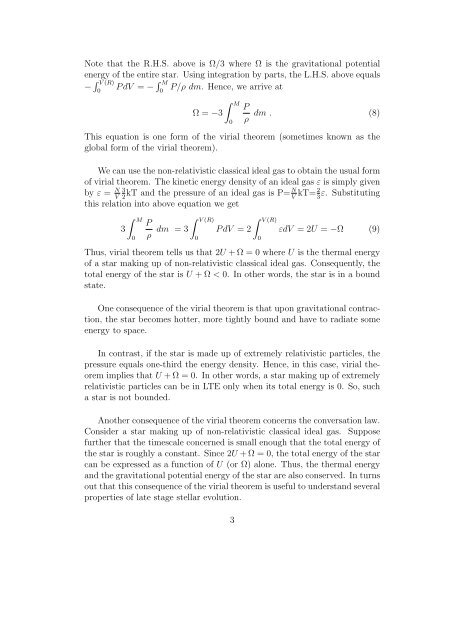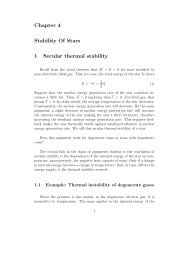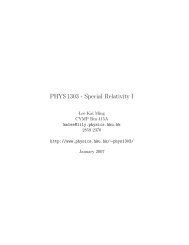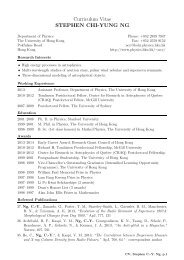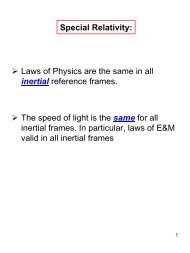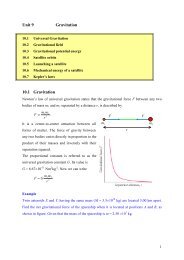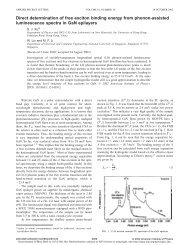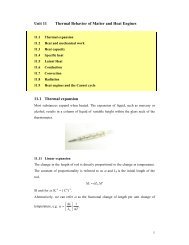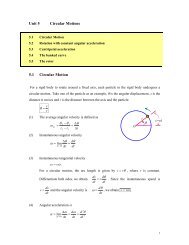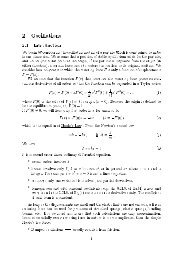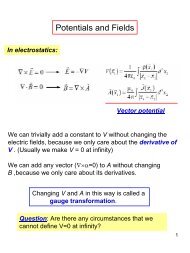Chapter 2 Stellar Structure Equations 1 Mass conservation equation
Chapter 2 Stellar Structure Equations 1 Mass conservation equation
Chapter 2 Stellar Structure Equations 1 Mass conservation equation
You also want an ePaper? Increase the reach of your titles
YUMPU automatically turns print PDFs into web optimized ePapers that Google loves.
Note that the R.H.S. above is Ω/3 where Ω is the gravitational potential<br />
energy of the entire star. Using integration by parts, the L.H.S. above equals<br />
− ∫ V (R)<br />
P dV = − ∫ M<br />
P/ρ dm. Hence, we arrive at<br />
0 0<br />
Ω = −3<br />
∫ M<br />
0<br />
P<br />
ρ<br />
dm . (8)<br />
This <strong>equation</strong> is one form of the virial theorem (sometimes known as the<br />
global form of the virial theorem).<br />
We can use the non-relativistic classical ideal gas to obtain the usual form<br />
of virial theorem. The kinetic energy density of an ideal gas ε is simply given<br />
by ε = N 3<br />
kT and the pressure of an ideal gas is P= N kT= 2 ε. Substituting<br />
V 2 V 3<br />
this relation into above <strong>equation</strong> we get<br />
∫ M<br />
∫<br />
P<br />
V (R) ∫ V (R)<br />
3<br />
0 ρ dm = 3 P dV = 2 εdV = 2U = −Ω (9)<br />
0<br />
Thus, virial theorem tells us that 2U + Ω = 0 where U is the thermal energy<br />
of a star making up of non-relativistic classical ideal gas. Consequently, the<br />
total energy of the star is U + Ω < 0. In other words, the star is in a bound<br />
state.<br />
One consequence of the virial theorem is that upon gravitational contraction,<br />
the star becomes hotter, more tightly bound and have to radiate some<br />
energy to space.<br />
In contrast, if the star is made up of extremely relativistic particles, the<br />
pressure equals one-third the energy density. Hence, in this case, virial theorem<br />
implies that U + Ω = 0. In other words, a star making up of extremely<br />
relativistic particles can be in LTE only when its total energy is 0. So, such<br />
a star is not bounded.<br />
Another consequence of the virial theorem concerns the conversation law.<br />
Consider a star making up of non-relativistic classical ideal gas. Suppose<br />
further that the timescale concerned is small enough that the total energy of<br />
the star is roughly a constant. Since 2U + Ω = 0, the total energy of the star<br />
can be expressed as a function of U (or Ω) alone. Thus, the thermal energy<br />
and the gravitational potential energy of the star are also conserved. In turns<br />
out that this consequence of the virial theorem is useful to understand several<br />
properties of late stage stellar evolution.<br />
3<br />
0


